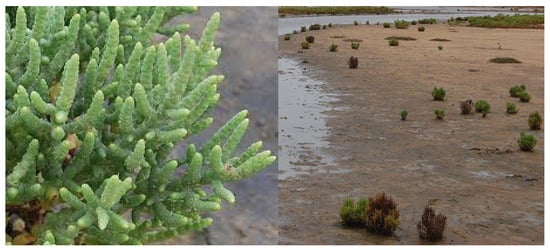Plant-based bioactive compounds containing substantial quantities of polyphenols have been gaining much attention nowadays. Our obtained antioxidant results revealed a broad variability in antioxidant values depending on the methods used because antioxidants may exert their effect through various mechanisms. This variability was attributed to the interference of the reaction mechanism and the tested solvents. Typically, the nature of the active molecules present in the samples as well as the presence of phenolic compounds with a certain structure and particular hydroxyl position in the molecule, which can act as a proton donor and show radical scavenging activity. Parallel to that, our antibacterial results showed that Gram-negative bacteria are more resistant than Gram-positive bacteria to the various extracts, especially the ethanol, due to their distinctive structure and to the bacterium’s outer-membrane barrier for Gram-negative bacteria. Their resistance was amplified via chromosomal mutations and lateral gene transfers.
The ethanol extract of
A. indicum shoots as the most active was dominated by TPC and TFC, which was well supported by LC-MS analysis with the major secondary metabolite being
trans-ferulic acid with the contents of 7432.51 ± 27.407 µg/g extract, followed by
p-coumaric acid (5982.57 ± 1.37 µg/g extract), respectively. TPC and TFC are widely present in plant extracts and have been considered significant contributors to their biological activities, exclusively due to their unique redox properties
[19]. Therefore, polyphenols containing hydrogen-donating groups have the ability to react with oxidants
[20]. Phenolic compounds can also intervene as a potential free radical scavenger by blocking the ROS-induced cytotoxicity and simultaneously decreasing lipid peroxidation and DNA damage
[21]. The high level of TPC in ethanol, 80%, might be related to its capacity to solubilize more secondary metabolites displaying a polar character and the higher solubility of a lot of extractable bioactive molecules in this solvent. The highest antioxidant activity of
A. indicum shoot extracts towards the DPPH test may be due to its polyphenol contents. These two compounds might be greatly involved in the biological activity of this extract, with the others minor by the synergism effect.
Trans-ferulic acid (4-hydroxy-3-methoxycinnamic acid), which is known for its potent antioxidant activity, is found in many food products and fruits and is used in cosmetology
[22]. The safety of ferulic acid has been demonstrated with evidence that a high level of ferulic acid (0.5 and 1 mM) does not affect the cell viability in 786-O human renal cancer cells
[23]. Besides that, the anticancer activity of ferulic acid has been proven against different cancer cells, including breast cancer cells (MCF-7) and liver cancer cells (HepG2)
[24], human urinary bladder carcinoma (T24)
[25], human osteosarcoma (143B and MG63)
[26], human breast cancer (MDA-MB-231)
[27], and human renal adenocarcinoma (ACHN) cells
[28]. Additionally, the inhibition of A549 and HT29-D4 cancer cells was induced by ferulic acid
[29]. Ferulic acid has been proven previously for its antioxidant activity, which was mainly related to its resonance stabilization
[30]. Ferulic acid helps in neutralizing the free radicals. Bami et al.
[30] suggested ferulic acid can hamper oxidative stress and regulate the levels of protein nitrotyrosine, malondialdehyde, blood urea nitrogen, myeloperoxidase, total antioxidant status, and creatinine in rats treated with cisplatin. Alam et al.
[31] reported that ferulic acid improves cardiovascular and kidney structure. It was able to decrease the hydrophobicity of
P. aeruginosa [32]. In the study of Ijabadeniyi et al.
[33], ferulic acid was well demonstrated for its antimicrobial activity
[33]. Merkl et al.
[34] stated that ferulic acid could inhibit the growth of
E. coli. In addition to all of the above, ferulic acid has been proven for its neuroprotective and antidiabetic properties as well as having high synergistic interaction with hypoglycemic drugs
[35][36][37].
The second major identified compound in
A. indicum shoot ethanol extract,
p-coumaric acid (4-hydroxycinnamic acid), is a natural ligand abundant in many fruits, vegetables, and cereals with diverse health benefits. The safety of
p-coumaric acid has been investigated, and the results outlined no significant cytotoxicity
[38]. Previous studies have demonstrated the significant relationship between
p-coumaric acid and antioxidant and antihyperlipidemic activities
[39]. The authors suggested that
p-coumaric is a potent antioxidant with potential therapeutic efficacy for treating hyperlipidemia symptoms
[40]. Kilic et al.
[39] reported that it is a good scavenger. Besides that, the antimicrobial role of
p-coumaric acid has been proven. Boz et al.
[41] demonstrated the antimicrobial activity of
p-coumaric acid allows the disrupting of bacterial cell membranes
[41].
p-coumaric acid was found to inhibit the proliferation and migration of cancer cells
[42]. Moreover, the chemopreventive effects of
p-coumaric acid on colon cancer have been illustrated
[43].
The third predominant compound was found to be rutin (3,30,40,5,7-pentahydroxyflavone-3-rhamnoglucoside), which exists in high levels in ethanolic extract (4108.17 ± 14.31 µg/g extract) and acetonic extract (7987.96 ± 18.73 µg/g extract), and must be taken into account. Rutin has been verified for its carcinogenicity, and data showed no carcinogenic potential in non-inbred golden hamsters. In fact, the flavonol rutin has been studied for its antidiabetic effect. It was added for glycemic control by increasing the insulin receptor kinase property
[44]. Also, it possesses a protective effect on hepatic and cardiac toxicity
[45]. The pharmacological properties of rutin have also been widely studied, including its antileukemic potential
[46], anti-inflammatory, antimicrobial, anticarcinogenic, neuroprotective, antithrombotic, and antiviral activities
[47][48].

